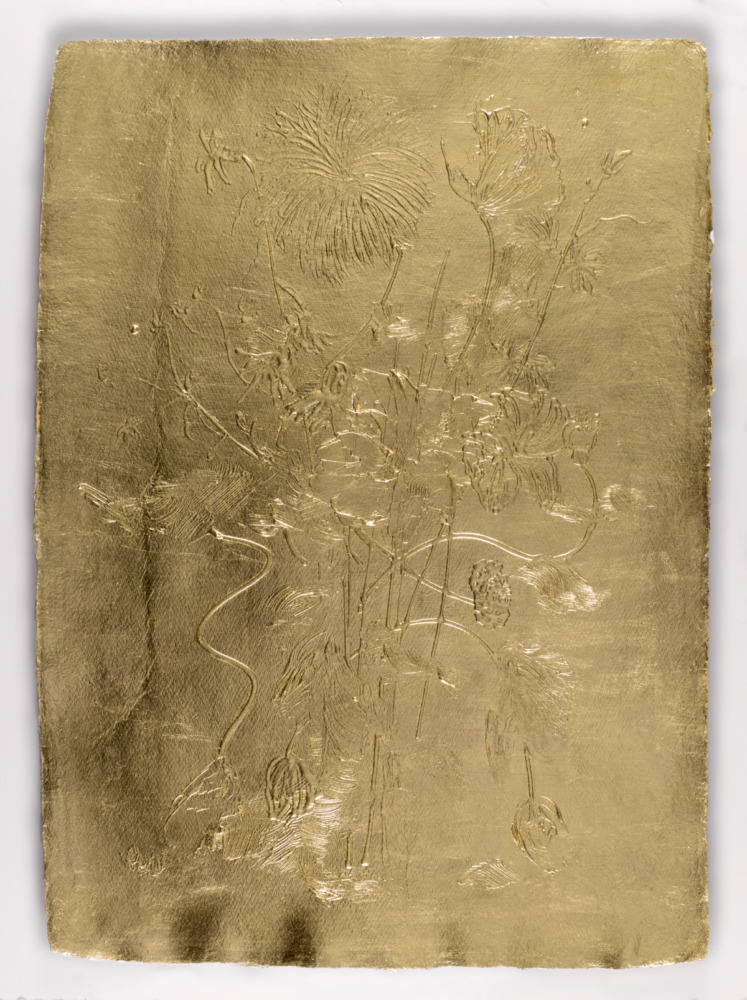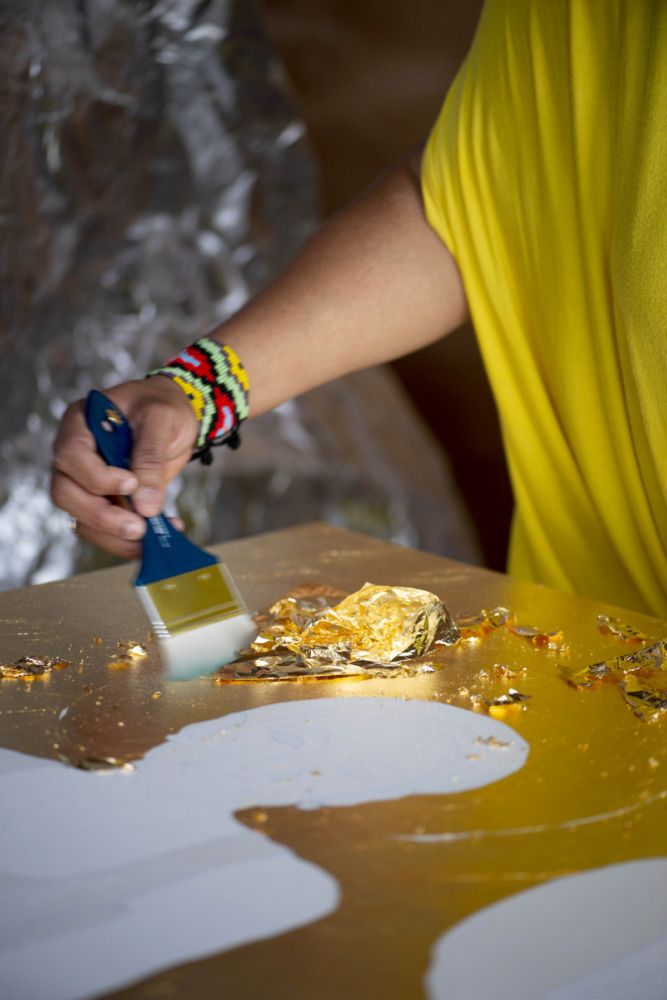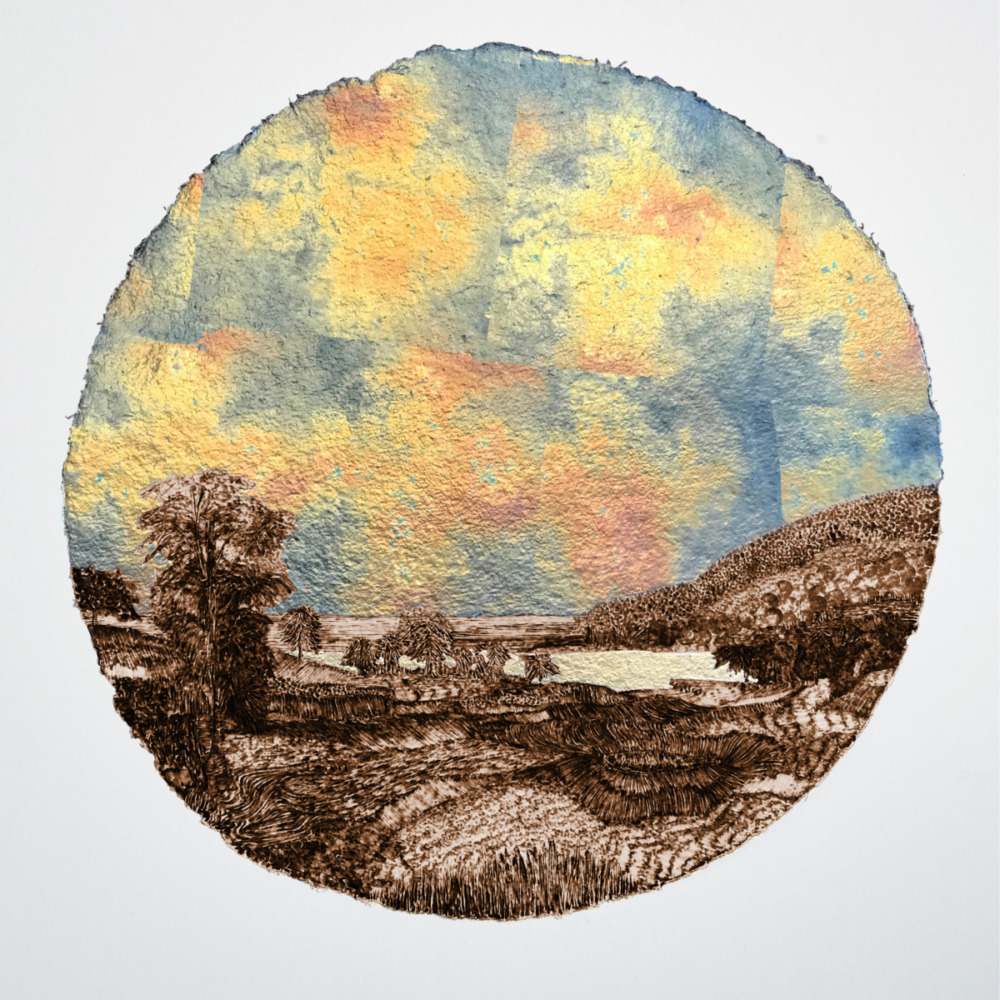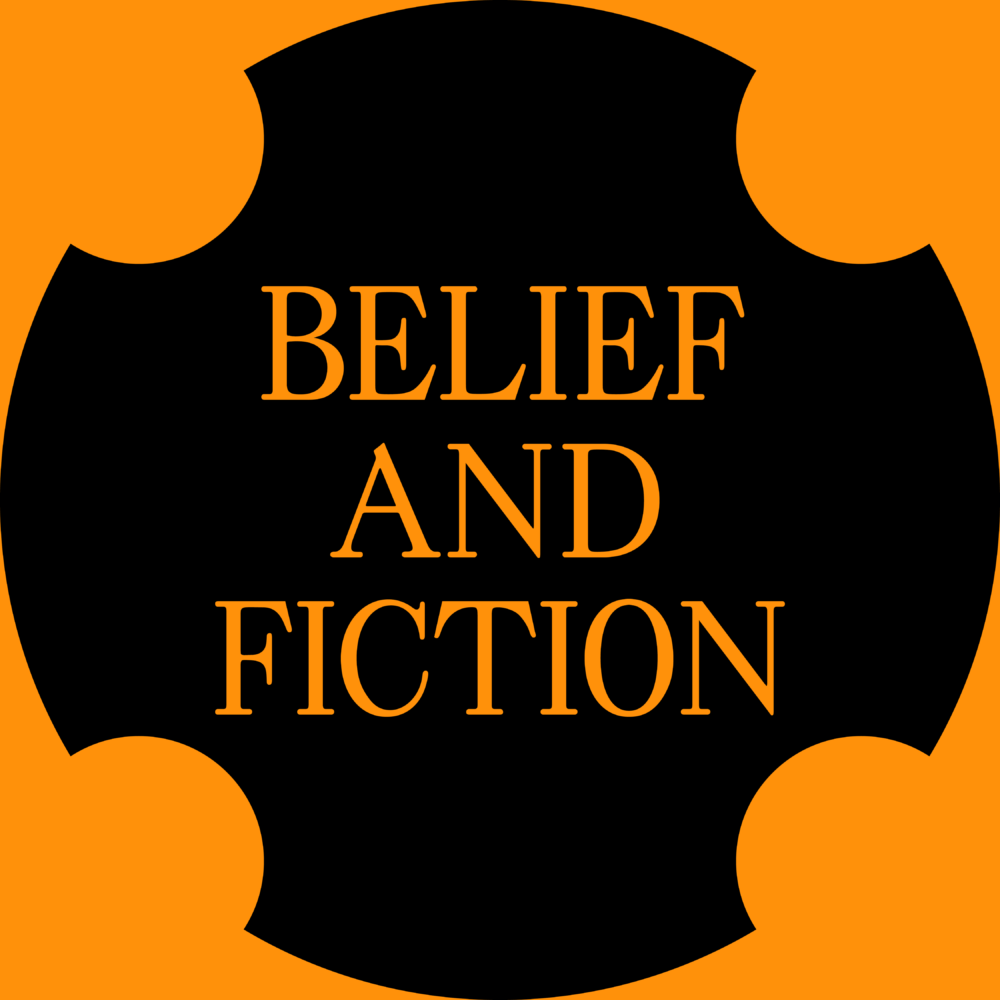
I made the pilgrimage from Charlotte to Durham, North Carolina, to visit the studio of Stacy Lynn Waddell and see her newest gilded portraits before they were packed and shipped. Waddell’s exhibition Mettle is on view September 10–October 16 at Candice Madey Gallery in New York City. The artworks in the show draw inspiration from three “Golden Ages” of artistic achievement: seventeenth-century Dutch flower painting, nineteenth-century American painting, and 1960s youth culture in Mali.
I saw Waddell’s work for the first time in the 2019 exhibition Painting Is Its Own Country at the Harvey B. Gantt Center for African-American Arts + Culture in Charlotte. Entering that one-room show, I was immediately seduced by a large sheet of gold shimmering on the white wall. When I moved towards it, it shapeshifted, and a barely-apparent image emerged: a cropped triad of people facing forward signifying a family portrait. I moved in a semicircle around the artwork and as I did, its image concealed and revealed itself like a Magic Eye picture. In Waddell’s gilded portraits, layers of gold leaf are built up and tamped down to subtly form shape, depth, and texture that are nearly undetectable. In order to decipher the images, the viewer must slow themselves and move in tandem with the light reflecting off the picture’s gold surface.
This year, I encountered her work again in Silent Streets: Art in the Time of Pandemic, an exhibition at the Mint Museum in Charlotte that explored art-making in the time of pandemic and for which Waddell was commissioned to create new work. The result was an installation of three flags in red, white, and blue made of canvas, heirloom fabrics, reclaimed denim, and textiles deaccessioned from the Mint Museum’s fashion collection. For each flag, Waddell abandoned the common pithiness of artwork titles and instead gave them lengthy honorifics that illuminate the lives of the Black women for whom they are made: her maternal grandmother Anliza Massenburg Gill, Harriet Tubman, and the young Black women of the Student Nonviolent Coordinating Committee (SNCC, founded at Shaw University in Raleigh, NC) . The carefully embellished flags require viewers to circle and examine them closely to make out their details.
The unifying feature between Waddell’s gilded portraits and her flags—two seemingly different types of work—is their physical demand on the viewer. Across all mediums she employs, Waddell elicits rituals for seeing.
The following interview with the artist was conducted in her studio on August 22 and has been edited for clarity and length.
______________________________________________________________________________
Susan Mackey: When I saw your installation of flags in Silent Streets, I was surprised and delighted to read on the label that you were the artist because it is so different from your other work; you work skillfully across so many different mediums.
Stacy Lynn Waddell: Yeah, that’s how I always envisioned myself being able to work. Flags and monuments have been in our mindscapes for a long time. Because [monuments] are in central locations, they hold positions of power in terms of their audience—and flags are a part of that. There’s power in a group, and there’s power in the entity that can create a situation where everyone is focused on, looking at, and thinking the same thing.
What these gold-leaf works do is they disrupt the observational process. These works require you to look deeper. They ask you to spend more time. What’s embedded in the work isn’t on the surface—it is but it isn’t—and so light and atmospheric conditions play into what you’re going to see.
I’ve been reading a New York Times article about a woman by the name of Jennifer Eberthardt.[1] She’s a social psychologist at Stanford [University], and she does studies about [racial] profiling that show [that] subjects who are darker and who are obviously male are seen as more threatening. That is because we have these iconic things, these symbols, that have been decided are dangerous—those are racial markers, those are gender markers.
We understand the importance of symbols because of George Floyd. Seeing that horrific murder take place—thankfully through a brave bystander [Darnella Frazier]—we understand the importance of seeing something and sort of gathering around a symbol. And George Floyd has become a symbol, we can clearly see that. But even that, even being able to see [Floyd’s murder]… We all saw Rodney King [being beaten by police], too. To see it still didn’t make a difference. It [has taken] from Rodney King to now for us to really believe our eyes, to believe what we’ve seen. So, what these gilded portraits do is call into question what we’ve seen. They [require] the work of really looking—or creating a relationship with something that might be spiritual or psychic, or physical; [the images you see are] going through the mind and brain and into the gut, and maybe the heart, and sort of circulating through [your] circulatory systems, and then they are processed. And that’s what I’m asking you to do.
The gold-leaf pieces are [appealing] because they’re gold and anything that’s shiny, there’s an attraction to it. They aren’t graphic. There are no definitive edges and regions that describe things or that signify what’s what. From various vantage points as the light hits the surfaces, you get a glimpse of something, a ghosted image. You’re not quite sure—you need to move in and move out. But once you’re there, then that’s where I want to hold people—to begin to help people think about what it means to [spend time with a work of art] that you can’t quite make out—why would you want to try and work through something that’s nuanced? That’s quiet? The work isn’t screaming. It’s just below the surface.
You know, the materials and the processes that I use—I’m burning paper, gilding things—I’ve always been drawn to things that aren’t necessarily directly linked to art-historical, traditional canon.
SM: Right, in your other works you use a rancher’s branding iron, acetylene torch, and blacksmith’s tools. You seem to have a rural skill set that I appreciate.

SLW: I want materials that can do the work and open the conversation about other things, not just art, not just formal discussions about what paint can do, and what bronze sculptures do. Sometimes I use 22-carat [gold], which obviously won’t change over time, but [these gilded portraits] are mostly composition gold or “Dutch gold.” What it means is that [when left] unsealed—and these are not sealed, because I want you to really see whatever texture is there—they will slightly, ever so slightly, shift.
That transformation is something that I’m interested in. There’s something unstable about putting a potentially tarnishable material out into the elements. Now, you know, in a gallery or in someone’s home collection they’re fairly safe, but they will shift just a little bit over time. And I’m excited about that because it’s like a record of time that links to a timeline of the images.
SM: Tell me about your use of Malian photographer Malick Sidibé’s photographs in these new gilded portraits.
SLW: Most of my work starts with a photograph, whether it’s traditional photography, or something I pull out of a magazine or the sort of cheap calendar of islands and landscapes. But it starts with an image that I did not necessarily create. I collect a lot of photography—a lot of vernacular photography—so I have a giant collection of those.
What is fascinating to me about Sidibé is that in the ‘60s during that golden age, [Mali] was coming into its independence, and largely seen through his lens is a youth culture that is connecting with the American music culture of the time.
My parents threw house parties—I was born in [19]66 [during the era of] Motown—where they would get together with friends. There are pictures of my parents posed in front of the hi-fi and people dancing. So, I’m thinking about music and the time and how Motown itself is an icon of Black excellence and Black creativity, Black ingenuity, American ingenuity. It’s quintessentially American. And so, to see [in Sidibé’s photographs] these young people dancing and posing in Sidibé’s studio really reflects a youth culture that we really—especially here in the United States—idolize. Everybody wants to look back at that time when they were in college, or just after, and hanging out with their friends. It’s a kind of freedom.
So, I’ve been thinking about youth culture, and the freedom one feels in their youth, and a country coming into their own independence. I’m thinking about the way that America tosses around words like “freedom,” especially now during COVID when wearing a mask is seen as unpatriotic or holding you back from being free. Asking everyone to, as we’ve done [during the] World Wars, collect cans and save things, and be a part of a national effort to look out for each other—that isn’t something that resonates anymore. You have a whole half of the country that completely pushes back on that.
SM: I’m curious about your new gilded flower pictures, which are inspired by seventeenth-century Dutch still lifes, because they seem like such a departure from your portraits.
SLW: Those paintings from the 1600s are portraits in that they are portraits of natural history and portraits of beautiful flora [symbolizing] the top of the hierarchy of [Dutch Golden Age painting]. We think about floral painting being the ultimate in terms of a pastime like flower arranging—that is quite benign and banal when you think about it now—but we’re talking about artistry, we’re talking about commerce, we’re talking about how the whole world can come together in terms of flowers. When you think about the global flower market: go to your local florist, and go to a flower market, and buy wholesale flowers, and they’re from all over the world.
Not many people don’t like flowers—they’re beautiful. And so, this idea of beauty is something that runs in my work a lot. In this show, Mettle, I want people to connect to this idea of being tough, having grit, sticking around, enduring. And ideas related to freedom and beauty. Although, beauty is not something that we like to talk about in contemporary art. It’s quite antiquated to talk about something being “beautiful,” right? It somehow diminishes the contemporary-ness or the conceptual nature of the work. But it doesn’t—it’s a device for me. I want you to be attracted to the material. I want you to be attracted to the process. I don’t mind if the interest in the work begins with being inquisitive about how the work is made.
SM: The words I keep coming back to are “magical,” or “alchemical.” It’s not as simple as looking at it and being affected by its beauty; rather, it’s transformative because it compels you to move your body around it in order to discern what’s there, and then it reveals and conceals itself.
SLW: Yes, there’s this book called What Painting Is written by James Elkins—that book is everything, like the fine print of this show. Because [Elkins] takes you so deep into the chemistry, he’s taking you into this kind of psychic space. He’s making you think about the reverence, the kind of spiritual nature [of painting]. I mean, go into any painter’s studio and [look at] the setup: the glass-top table for mixing, and then the palette knives, and the brushes, and the turpentine or whatever it is you’re using. There’s something about that ritual—the mixing and making. In this work, the way that it’s made, there’s ritual and a kind of reverence and daily meditation, you know. It’s a meditation.
SM: I was going to ask you about your own personal spiritual connection to making the work.
SLW: It’s a meditation. For me, reading Elkins’s book—I found it in graduate school and I’ve never forgotten about it—[made me think about] how much I can eke out of the materials that I use and the processes that I use. And that, to me is, is a kind of reverence that we artists have, that you as a writer have for words, right?
SM: Absolutely.
SLW: Read passages of your favorite writers and you think, “How did they? Where did this come from?” How does it come through them, through the mind and through the body and the pen, and out onto the page or onto the screen? That’s a place where I want to suspend the viewer, again, in a world that is fast-paced and that has so many more options.
The [gold-leaf] material is organic—it’s still life. It’s still living, there’s still possibility, it’s not static at all. I think living with an artwork that shifts a little bit over time is an interesting idea. It’s a way of sort of living with the potential of something that you can’t measure. You can’t price that. It’s a potentiality that I think about [with regard to] where to hang the work, or what space makes sense; but it’s not that the work is degrading, it’s just changing. It’s just changing and evolving.

SM: There’s a lovely irony in your work when you marry this precious material with these very quotidian images. I heard you mention earlier that you collect vernacular photos…
SLW: I do. Like all of my photographs I find them everywhere—at yard sales, estate sales, or the scrap exchange here in Durham. Typically, what I’m looking for is [images of] Black life, whether it be school pictures or family photos of family reunions or weddings. For me, it’s a kind of reclamation project; it’s a way of getting these images of people who look like me, who are doing things that my family does, that I can directly relate to. But in a way, it’s a loving project of giving them my home and getting them out of this bin where all these people will rifle through them and maybe not love them, or respect or understand. So, you know, pictures are records—they’re records of our lives. They’re precious to me.
SM: I think that your choice of vernacular photos is really special. When I saw your work Untitled (Family Portrait) at the Gantt Center, like you said, I was immediately attracted to the gold. I approached it, and moved around it, and shifted my perspective to see; and then when I was finally able to make out the image it wasn’t a religious figure like I was primed to expect. It was a common, everyday portrait of a family.
SLW: The family portrait is my mom and sister and me. Sometimes I use personal photographs. In the beginning, when I started making these, I was obviously thinking about religious icons. I was thinking about statuary and things that we revere that are [made] to help us have a religious or spiritual experience.
The illustrative and the decorative are really interesting to me because they communicate—they pull you in to communicate something. And yet, with these [gilded portraits], what’s being communicated isn’t necessarily clear: there is no racial marker, right? You might find some things that look more Black or ethnic in some way, but it’s hard to pin down. I’m asking you to take these images as human beings and not as anything other than that. But what does it mean to exist? And what does it mean to assign beauty to something?
SM: Your gilded portraits are like ghosts of the photos.
SLW: It’s a ghost of the photo and it [reveals something] about the process of how photographs come into being, which is important to me—the way that analog photography is made in a darkroom where something is developed, and we stop it, and we fix it. That’s what I’m asking you to do throughout the observational process. How does [the image] come into being? How slow, how fast? And where do you find that place where you stop it? You see it, you freeze it, and then you take it in; that all is the viewer’s work to do. But there is a connection in my mind [between] the observational experience and the developmental process that happens in the darkroom: chemical or alchemical, a kind of magic that happens.
Mettle is on view at Candice Madey Gallery in New York City thru October 16.
[1] Dreifus, Claudia. “Perceptions of Race at a Glance.” The New York Times. The New York Times, January 5, 2015. https://www.nytimes.com/2015/01/06/science/a-macarthur-grant-winner-tries-to-unearth-biases-to-aid-criminal-justice.html.

This essay is part of Burnaway’s yearlong series Belief and Fiction.
Find out more about the three themes guiding the magazine’s publishing activities for the remainder of 2021 here.




